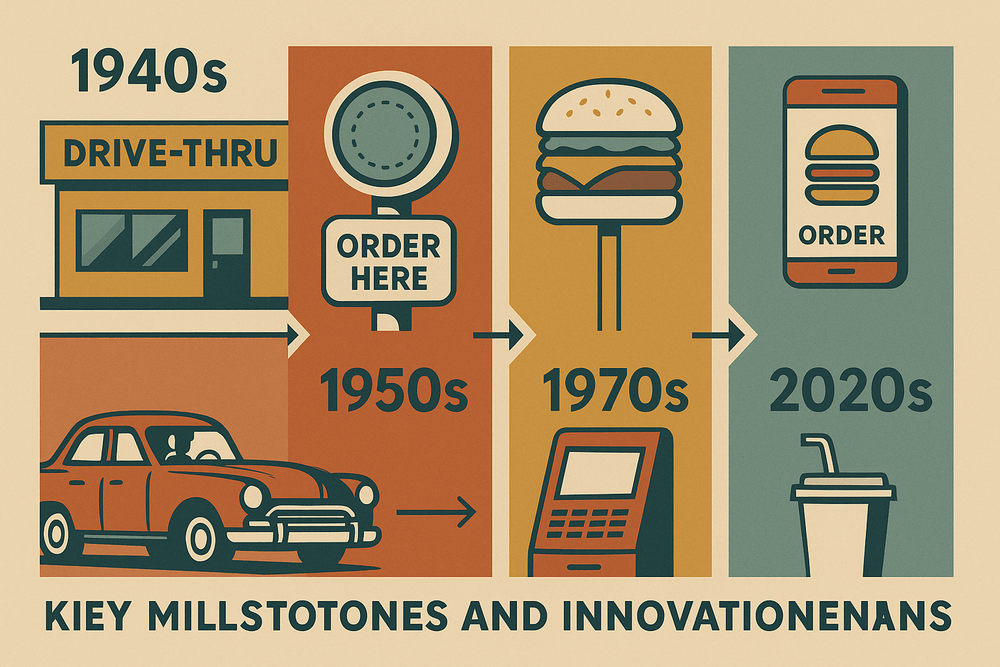
Drive Thru Restaurant History: Key Milestones and Innovations
Jai Tamboli
Exploring major milestones in drive thru history.
Drive thru restaurants have become an essential part of the fast-food industry, offering convenience and speed for millions of customers worldwide. The drive thru restaurant history is a fascinating journey filled with innovation, adaptation, and consumer-focused improvements that have shaped how we eat on the go today.
The Origins of Drive Thru Restaurants
The concept of the drive thru began to take shape in the early 20th century when automobile ownership was rapidly growing. Before this innovation, fast food was primarily consumed inside restaurants or through simple take-out windows. The rise of cars created a demand for new ways to serve customers efficiently without requiring them to leave their vehicles.
One of the earliest examples of drive thru service dates back to the 1930s when In-N-Out Burger in California began operations. However, the first official drive thru is often credited to Red's Giant Hamburg on Route 66 in Springfield, Missouri, which opened a walk-up window in 1947. These early models focused primarily on walk-up or drive-in service rather than the streamlined communication systems we associate with drive thrus today.
Technological Innovations That Shaped the Industry
The drive thru restaurant history took a significant leap with the introduction of the two-way speaker system. This technology allowed customers to place their orders easily without leaving their cars or yelling to staff. The first use of this innovation was by Jack in the Box in the early 1970s. This system dramatically improved order accuracy and speed, two crucial factors in a fast-paced environment.
As technology advanced, integration of point-of-sale (POS) systems and digital display menus further enhanced efficiency. These innovations allowed restaurants to update their menus remotely and handle more complex orders. The drive thru restaurant history is marked by these steps toward automation and smoother customer interactions.
The Evolution of Convenience and Customer Experience
One of the main drivers behind the evolution of drive thru restaurants is the focus on customer convenience. Over the decades, the design of drive thru lanes and ordering points has been refined to accommodate more vehicles and reduce wait times. Multiple lanes and order points began to appear in the 1980s and 1990s, addressing growing demand.
Alongside physical improvements, staffing and training also adapted. Employees became specialized in different roles—taking orders, preparing food, or handling payments—to speed up the entire process. These operational improvements highlight the importance of efficiency in drive thru restaurant history.
Adapting to Modern Trends and Technology
In recent years, the drive thru industry has embraced digital ordering platforms and mobile apps that allow customers to order ahead and skip lines altogether. This shift is part of a broader move toward integrating online and offline experiences, making the drive thru model more flexible and responsive to consumer needs.
Moreover, sustainability initiatives have started to influence drive thru design and operations. Energy-efficient lighting, biodegradable packaging, and reduced idling times are some of the ways restaurants are addressing environmental concerns while maintaining convenience.
Impact on the Fast Food Industry
The drive thru restaurant history demonstrates how innovation and adaptability can revolutionize service delivery. Today, drive thrus are the backbone of many fast-food chains, accounting for a significant portion of sales. They have expanded beyond traditional burger and fries to include healthier options and specialty items in response to changing consumer preferences.
This method of service has also opened opportunities for restaurants to operate during non-traditional hours and in locations where dining rooms might not be feasible, such as airports or busy highways. The drive thru model continues to evolve, reflecting the ongoing changes in technology and consumer behavior.
Future Prospects of Drive Thru Restaurants
Looking ahead, the drive thru restaurant history is set to continue with innovations such as AI-powered ordering systems, voice recognition technology, and autonomous delivery vehicles. These developments have the potential to make the drive thru experience even faster, more personalized, and efficient.
Additionally, as urban environments become more congested, redesigning drive thru lanes to minimize traffic impact and integrate better with public transportation and walking customers will be essential. The future of drive thru service lies in blending traditional convenience with new technology and sustainable practices.
Conclusion
Understanding the drive thru restaurant history provides valuable insights into how consumer demand and technological advancements influence the food service industry. From humble beginnings to the high-tech systems used today, drive thrus have continually adapted to meet the needs of fast-paced lifestyles. As this sector grows and innovates, it will remain an important facet of quick-service dining for years to come.